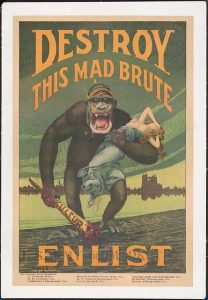50 Visual Rhetoric
OVERVIEW
Below is a graphic display of a home. Some things work well (cabinetry and counters i the kitchen and a fireplace in an adjoining living area) while others don’t quite achieve the desired effect. For example, what does a fireworks sign have to do with cooking? Why is there a bust inside the fireplace? What could the designers or homeowners have used instead?

VISUAL RHETORIC DEFINED
Visual rhetoric is a special area of academic study unto its own. It has a long history in the study of art and semiotics (the study of symbols) and it has kinship to the classical study of oral rhetoric such as persuasive speeches and legal arguments.
For the purpose of our studies, we will define the phrase “visual rhetoric” as the means by which visual imagery can be used to achieve a communication goal such as to influence people’s attitudes, opinions, and beliefs. The study of visual rhetoric, therefore, is to ask the question, “How do images act rhetorically upon viewers?” (Hill, C. A., & Helmers, M., 2012, p. 1).
The techniques of visual rhetoric align with the classic pillars of rhetoric:
- Ethos – An ethical appeal meant to convince an audience of the author’s credibility or character.
- Pathos – An emotional appeal meant to persuade an audience by appealing to their emotions.
- Logos – An appeal to logic meant to convince an audience by use of logic or reason.
One of today’s most familiar uses of visual rhetoric are the memes you see in social media. Memes, in an incredibly concise and penetrating way, are able to punctuate a dialogue or issue with “likes” and shares calculating a somewhat blunt measure of their popularity.
An example of a popular meme as documented by the KnowYourMeme.com website.
From KnowYourMeme.com: “Success Kid, sometimes known as I Hate Sandcastles, is a reaction image of a baby at a beach with a smug facial expression. It has been used in image macros to designate either success or frustration. In early 2011, the original image was turned into an advice animal style image macro with captions describing a situation that goes better than expected.” © KnowYourMeme.com All Rights Reserved
So if memes are a common part of your daily communication, it is a good entry point for describing the capability of visual rhetoric.
Read Purdue OWL: Visual Rhetoric Overview
This brief resource will show a graphical representation of visual rhetoric in relation to other disciplines plus some references to other research.
Read The American Institute of Graphic Arts (AIGA) – Visual Rhetoric: An Introduction for Students of Visual Communication
This article provides an overview of visual rhetoric as a body of knowledge within visual literacy and graphic design.
FOUNDATIONS OF RHETORIC
In this section, we will describe the areas of foundation knowledge that surround the principles of visual rhetoric.
RHETORIC: THE TECHNIQUES OF PERSUASION
Before describing the principles of visual rhetoric, it is important to fully understand the traditions of rhetoric in speaking and writing. The video below describes the foundation elements of rhetoric – logos, pathos, and ethos (logic, emotion, and credibility).
SEMIOTICS: THE STUDY OF SIGNS AND SYMBOLS
Visual imagery is analogue, meaning that it is analogous to, or bears a similarity to, that which it represents. Authors use the power of analogy to create a symbolic message.
In the example below (figure 1), we see a poster used during Word War I portraying a fierce gorilla symbolizing a terrifying German enemy while the draped bare chested woman symbolizes the spirit of American liberty. The poster is intended to convey the idea that, unless you enlist in the U.S. Army, the German Kaiser’s rabid soldiers would eventually land on American soil.

A reasonable person would know that there really wasn’t any risk of an actual gorilla landing on the shores of United States who would, in one hand, scoop up a helpless woman to carry around while he whacked things with his club. Still, the rhetorical effect contributed to a larger communication strategy at the time to foster an effort to increase recruitment. This was achieved through the use of overt symbolic references to real objects combined with dramatic composition techniques (the gorilla’s feet standing on top of the word “America”, bold typefaces, blood colors, stormy green skies, and urgent text).
The study of symbols, metaphors, expressions, and signs to represent ideas, emotions, action, and information is the discipline called semiotics. Semiotics extends to other realms of communication such as color coding, art, graffiti, universal codes for public spaces, and even to the wordless assembly instructions of a piece of IKEA furniture (see figure 2).

Techniques of visual rhetoric include using symbolic references to elicit a reaction from your audience. So as you select some kind of imagery as part of your visual communication, you would be employing the psychological language of symbolism to achieve your effect.
Key Takeaway #1
Using images as symbols for ideas, expressions, ideologies, and other entities is an effective way to promote your message.
LINGUISTICS: THE STUDY OF LANGUAGE AND DISCOURSE
Language: Linguists study language in both its written and spoken form including its historical, cultural, anthropological, and political backgrounds. As described in the Introduction chapter, written language is produced in the form of a code (the alphabet). Words, as a code for a specific meaning in the dictionary, are often insufficient in conveying the intended meaning of a message unequivocally. If you have ever experienced the awkwardness of an email message or social media post that was misinterpreted by others in the worst possible way, you are familiar with this phenomenon.
The cause of this problem is rooted in the complexity of conveying a message in a medium that is too lean to punctuate how the message is to be interpreted. An example would be the difference between sending a letter to one’s beloved versus saying the same words in person. The beloved’s interpretation of the same message in the form of a letter could be different than if it were conveyed face-to-face even if the same words were used. The absence of non-verbal cues in the letter could cause a certain sarcastic or humorous passage to be errantly perceived as an insult.
Famed linguist Gregory Bateson (1968) described how a message is segmented into “content” and “relationship”. While the content could be described as the literal meaning of words as decoded by the lexicon of our language, the relationship portion of a message is the part that cues the receiver about how that message is to be taken as.
It is the author’s challenge to account for the audience’s need for both meaning and interpretation.
Discourse: We use language as the basis of human discourse, which is defined as “the production of knowledge through language” (Hall, 1997, p. 44). Hall’s inclusion of the word “production” supposes that knowledge is a process of human construction: As we communicate, we are constructing a shared sense of truth and reality while forming the contours of a social world. Our social world “… is the overall outcome of our joint processes of social – specifically, communicative – construction” (Couldry, N., 2018, p. 18).
As you construct messages through the use of oral, written, and visual media, you are, in essence, creating a shared understanding – a reality – through a social process communication.
Key Takeaway #2
You will be challenged to compose messages so that they are interpreted by your audience as you intended to create a shared sense of reality.
VISUAL RHETORIC IN PRACTICE
The traditional study of rhetoric, as the video in this chapter describes, is the study of communication in the art of persuasion. The term visual rhetoric suggests that there is kinship with traditional oral rhetoric and written rhetoric, but in a different (visual) form.
For example, in the print ad below for Pinnacle Bank, the visual element has nothing to do with banking, but has everything to do with persuading the viewer that the bank has ethos, or credibility, with respect to the individuals or businesses they are appealing to. To the audience, the selection of a farm image is intended to recognize the audience’s perspective, interests, traditions, and livelihood so that it promotes feelings of trust, connection, and mutual understanding, even though the occupations of banker and farmer couldn’t be more different.

In the example below, we see an effort to appeal to both emotion (pathos) and logic (logos) in the famous “Morning in America” TV ad from the 1984 presidential election. The emotional elements are triggered through the use of the wedding scene and the flag raising scene. The logical element, expressed in the narrator’s voiceover, is presented in the form of economic statistics and reinforced by a question that asks why we would want to return to the conditions that preceded president Reagan’s first term in office.
VISUAL RHETORIC VERSUS VISUAL DECORATION
Not all visual information in media is intended for a rhetorical purpose. In deconstructing visual media, you will be challenged to distinguish between visual imagery that is purposeful and imagery that has no particular purpose other than decoration. In the example below, the small parrot image, by itself, does not elevate the information on the chart to a higher level of meaning. Removing the image of the parrot would not take away from the meaning of the other information.
This is an example of an infographic where the image of the parrot in the bottom right corner does not promote a rhetorical effect. It is purely decorative. However, other images within this infographic DO have rhetorical effects, the parrot aside.

Globe-Trotting inforgraphic courtesy of: Commons:WikiProject Aviation/recent uploads/2016 October 1
In the example below, we see another infographic, this time where different images are used for a rhetorical effect (cube, puzzle pieces, arrow pointing up). In this case, the intended message is extended beyond the literal meaning of the words below the images of the people. The audience gets the sense that the entities served by this corporation are not just those listed, but that they embrace a spirit of diversity and inclusion. The effect of this strategy should be that prospective clients of all backgrounds are welcome to do business with this organization.

Engage! MSLGROUP Employee Survey Infographic is licensed by CC BY-SA 2.0 DEED
SUMMARY
Visual rhetoric draws upon the rhetorical traditions found in oral and written rhetoric and operates to achieve the same effect on human perception. Humans communicate using a combination of codes, symbols, analogies, and discourse to form a shared reality.
The author of visual media will need to account for the audience’s need for both information and how that information is intended to be taken as within a larger communicative context.
References
Bateson, G. (1968). Information and codification: A philosophical approach. In J. Ruesch, & G. Bateson (Eds.), Communication: The social matrix of psychiatry (pp. 168–211). New York, NY: Norton.
Couldry, N., & Hepp, A. (2018). The mediated construction of reality. John Wiley & Sons.
Hall, S. (1997). The work of representation. In S. Hall (Ed.), Representation: cultural representations and signifying practices (pp. 15-64). London: SAGE Publications in association with The Open University.
Hill, C. A., & Helmers, M. (Eds.). (2012). Defining visual rhetorics. Routledge.

